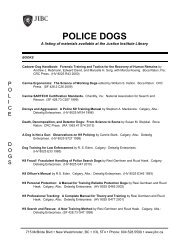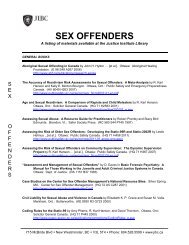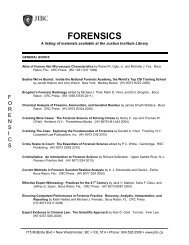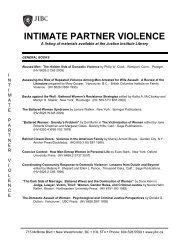legally speaking - Justice Institute of British Columbia
legally speaking - Justice Institute of British Columbia
legally speaking - Justice Institute of British Columbia
Create successful ePaper yourself
Turn your PDF publications into a flip-book with our unique Google optimized e-Paper software.
What Did the Accused’s Lawyer Tell Him?<br />
Do you ever wonder what a lawyer says to a client? During the<br />
Ashmore case the accused called his lawyer to testify. The lawyer<br />
said he frames the legal advice he gives in a positive manner so as<br />
to inform those under arrest what they should do. Here is what<br />
he said he told the accused:<br />
• That he had the right to remain silent. (This was repeated<br />
two or three times.);<br />
• That he should not say anything to the police beyond<br />
identifying himself;<br />
• That the police were entitled to ask him all the questions<br />
they want, and would do so, but that he should repeatedly<br />
say he does not want to talk to them;<br />
• That he should assert his right to silence by using<br />
expressions such as: “I don’t want to talk to you”; “I have<br />
nothing to say to you”; and “My lawyer told me not to talk to<br />
you”. (This was repeated two or three times.);<br />
• That he should not listen to the police as they will<br />
exaggerate evidence, misplay evidence, lie about what<br />
evidence they have, and try to trick him;<br />
• That the police might put someone in his cell and “bug” his<br />
conversations;<br />
• That he should act on the basis that the police are listening<br />
to all his conversations, except those with a lawyer;<br />
• That he should not provide the police with, or consent to<br />
the warrantless taking <strong>of</strong>, any bodily samples, such as hair,<br />
spit, blood, tissue, or anything from which a DNA sample<br />
could be obtained;<br />
• That he should be careful <strong>of</strong> any waste, such as blowing his<br />
nose into a tissue. Waste should either go into the toilet or<br />
be cared for;<br />
• That in the event that the police obtain a warrant for a<br />
bodily sample, he should say “I am not consenting but I will<br />
comply with the warrant”;<br />
• That the police were entitled to take his photograph but that<br />
he should not participate in any line-ups or take any lie<br />
detector (polygraph) tests;<br />
• That the police might ask him to participate in a test as a<br />
ruse to get him to talk;<br />
• That if he wanted to apply for legal aid, then he should do so<br />
at the earliest opportunity;<br />
• That the legal aid <strong>of</strong>fice was closed on the weekend but a<br />
legal aid lawyer would be available to him at the courthouse;<br />
and<br />
• That in a murder case the police have 24 hours to take an<br />
accused before a judge or justice <strong>of</strong> the peace, but there is<br />
no chance <strong>of</strong> being released before going to court. He should<br />
speak to a legal aid lawyer when he gets to court to start the<br />
process <strong>of</strong> seeking release.<br />
R. v. Ashmore, 2011 BCCA 18<br />
Volume 11 Issue 1 - January/February 2011<br />
PAGE 26<br />
STARTING SENTENCE FOR<br />
WHOLESALE COCAINE<br />
TRAFFICKING IS 4 1/2 YEARS<br />
R. v. Nishikawa, 2011 ABCA 39<br />
The accused sold 0.5 grams <strong>of</strong><br />
cocaine to an undercover <strong>of</strong>ficer for<br />
$80 then, after he was targeted for<br />
investigation police stopped his<br />
vehicle and found 10 ounces <strong>of</strong><br />
cocaine with an estimated street value <strong>of</strong> $47,000.<br />
He pled guilty in Alberta Provincial Court. On<br />
sentencing the Crown sought a four-year prison term<br />
while the defence proposed a conditional sentence.<br />
The judge imposed a conditional sentence <strong>of</strong> 10<br />
months for trafficking and 2 years less a day for<br />
possession for the purpose <strong>of</strong> trafficking, to be<br />
served concurrently.<br />
The Crown then successfully appealed the sentence<br />
submitting it was demonstrably unfit. The Alberta<br />
Court <strong>of</strong> Appeal has set starting points for trafficking<br />
in cocaine, whether at the commercial or wholesale<br />
level, which can be adjusted for the <strong>of</strong>fence and the<br />
<strong>of</strong>fender. The sentence for commercial trafficking in<br />
cocaine at something more than a minimal scale<br />
starts at three (3) years while the starting point at the<br />
wholesale trafficking level is four and a half (4.5)<br />
years. In this case the possession <strong>of</strong>fence was for<br />
trafficking at a wholesale level. Although at the low<br />
end <strong>of</strong> the range, the Court <strong>of</strong> Appeal imposed a<br />
sentence <strong>of</strong> 30 months imprisonment after<br />
considering the accused’s guilty plea, his favourable<br />
pre-sentence report, his family history, and his<br />
positive efforts in overcoming his addiction.<br />
Complete case available at www.albertacourts.ab.ca<br />
“Cocaine is a particularly<br />
insidious drug, one that wreaks<br />
havoc not only upon all who are<br />
addicted to it and those near<br />
them, but also upon society at<br />
large.”<br />
R. v. Nishikawa, 2011 ABCA 39






